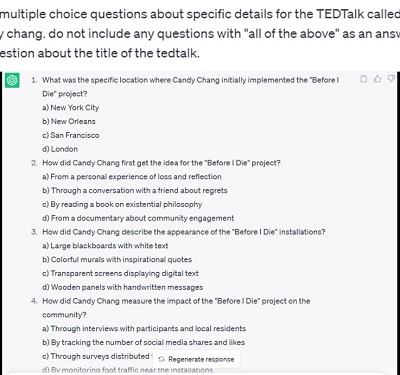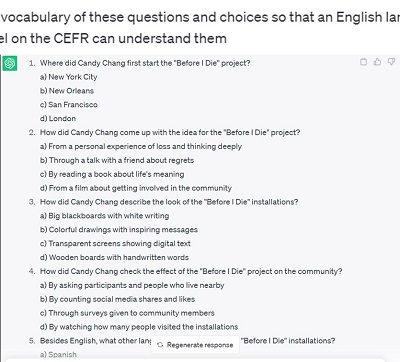|
To many people, the term artificial intelligence (AI) often conjures up an image of robots becoming so smart that they eventually outpace humans and take over the world – something straight out of a science fiction movie. Thankfully, AI technology isn’t quite there yet, but it has developed in such a way that it can be leveraged to help us humans pick up the pace, particularly in education. ChatGPT, or Chat Generative Pre-Trained Transformer, is one example that can help with this. In order to better understand this tool, it’s worthwhile to know how it works.
ChatGPT is a generative AI tool, which differs from traditional AI. Traditional AI follows predetermined rules and instructions to solve specific problems. Generative AI, on the other hand, can create its own solutions by learning from vast amounts of data input. In culinary terms, traditional AI is like a fixed recipe that is followed to the tee in certain situations, whereas generative AI is like a chef who learns from various recipes and can come up with new dishes on its own (OpenAI, 2023). According to Forbes, “The main difference between traditional AI and generative AI lies in their capabilities and application. Traditional AI systems are primarily used to analyze data and make predictions, while generative AI goes a step further by creating new data similar to its training data,” (Marr, 2023).
While all of this is useful information, the best way to fully comprehend ChatGPT’s capabilities is to simply experiment with it yourself. Once you become a bit more familiar with what it can do, it is easy to see how it can be a gamechanger for teachers, particularly when lesson planning or creating materials. With this in mind, the remainder of this article will focus on tip and tricks teachers can use so that ChatGPT is the one doing the heavy lifting.
If you’re an ESL/EFL teacher and you haven’t taken advantage of ChatGPT, you are potentially doing more work than you have to. There is one main point I want to highlight in this regard: getting the prompt right.
For a high pre-intermediate Listening and Speaking class I recently taught, I used a TEDTalk from the assigned textbook, but I didn’t like the questions it provided. So, I turned to ChatGPT to create new comprehension questions. As you can see from Table 1, I included a few key elements in my prompt: how many questions I wanted, the type of questions I wanted, and the material it should refer to.

Table 1 - Ten Questions Before I Die
In the initial response, the questions were open-ended when actually I wanted multiple-choice questions. I refined my prompt to be more specific, which can be seen in Table 2. I was sure to have the AI exclude some of my pet peeves, such as “all of the above” questions and obvious questions that can be answered without even doing the task.

Table 2 - Ten Multiple Choice Questions Before I Die
The second time around, the response was closer to what I had wanted, but the language was a bit too difficult for my lower-level students. So, I decided to refine my prompt again, as seen in Table 3. I included the general student profile of my class, including the type of student they are and their level. In principle, giving as much information as possible about the target audience of the material will help the AI to better deliver the desired output.

Table 3 - Questions Before I Die at CEFR A2
The response in Table 3 is what I had initially wanted, and with a few tweaks here and there, I was ready to go. I then asked ChatGPT to give me the answers to this revised list of questions, and it provided them in under 5 seconds.
As demonstrated in these examples, getting the prompt right is critical in getting what you want. You may need to try a few different wordings or simply click the “regenerate” button to have it try again with the same prompt. This may seem like it’s a waste of time, but keep in mind that ChatGPT is learning from you and the feedback you give it, and over time, it will start to provide you with answers that are more tailored to what you want. It’s also important to remember that ChatGPT is a starting point, so you should never just use what it produces without going over it and double check everything first.
Overall, these examples show just a fraction of what ChatGPT can do for language teachers. Among many other things, it can help you brainstorm ideas for activities to do in class; generate tables and charts that can be integrated with other EdTech platforms like Quizlet and WordWall; write examples essays for students to analyze; produce cloze quizzes with given vocabulary words; create rubrics for assessments; and even come up with an entire syllabus that includes a course description, objectives, weekly plans, and assessment methods. Again, the prompt is the key to getting the materials you want, but it’s still necessary to remember that ChatGPT is not perfect. It can’t always do everything we want it to do or in exactly the way we want it, so if refining your prompt isn’t getting you the output you want, you may need to fill in some of the gaps yourself. Nevertheless, ChatGPT is indeed an AI tool that can help humans, or teachers at the very least, pick up the pace when developing materials for their courses.
References
Marr, B. (2023, July 24). The Difference Between Generative AI and Traditional AI: An Easy Explanation for Anyone. Forbes. https://www.forbes.com/sites/bernardmarr/2023/07/24/the-difference-between-generative-ai-and-traditional-ai-an-easy-explanation-for-anyone/?sh=292826b7508a
OpenAI. (2023). ChatGPT (July 30 version) [Large language model]. https://chat.openai.com/chat
Heather Austin (M.A. Applied Linguistics) is an Assistant Professor at a private university in Japan. In addition to teaching, she has been actively involved in materials development, curriculum design, CALL, committee work, course coordination, and conducting research. Her professional and scholarly interests include sociolinguistics, materials development, extensive reading, fluency development, and educational technology. |

